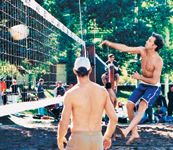Optometrist volleys between his practice and his sport
It's been 20 years since one optometrist has been in school, but he's still playing the sport he grew to love back then - beach volleyball.
While attending college in Provo, UT, Michael J. Vernon, OD, played many sports-everything from basketball to golf to soccer. Then, a group of friends persuaded him to play beach volleyball. It took a little coaxing, but they got him off lush courses, outdoor fields, and hardwood courts, and onto the sand.

"Beach volleyball is a much kinder sport on my body than other sports," said Dr. Vernon, now a 40 year-old optometrist, whose practice is located inside the local Walmart store. "I'm not afraid of twisting an ankle or breaking a leg."
More than staying in shape
To help stay in shape and maintain his stamina, Dr. Vernon said that he visits the local gym four or five times a week to lift weights and run.
While physical prowess is an important aspect of the sport, he said experience and mental strength are even more critical when playing competitively.
For example, Dr. Vernon said the game would test any player's patience and concentration, especially when one team is down by just a point or two. Likewise, experience helps players better predict not only how their own opponents will react, which he refers to as cat-and-mouse tactics, but also how their own partner will think and move during games. He points to younger, stronger players who lose games or tournaments because they're not in touch with themselves, falling apart mentally or emotionally when they lose a key point. Players must be mentally tough and know how to strategize, he said.
"One of the things I like about beach volleyball is that most of the professional players who belong to the Association of Volleyball Professionals hit their prime when they're in their early to mid-30s," he said. "It's a sport people can play competitively even into their mid-40s. I've seen a number of players dominate the sport, and be the best in the sport when they were in their 40s."
Newsletter
Want more insights like this? Subscribe to Optometry Times and get clinical pearls and practice tips delivered straight to your inbox.